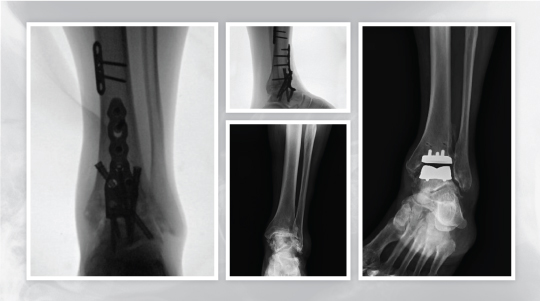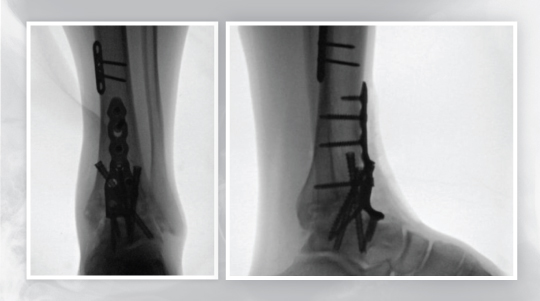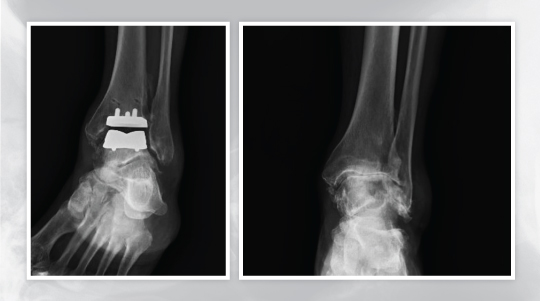Ankle Replacement or Ankle Fusion for Painful Arthritis of the Ankle?

Ankle arthritis has a significant negative impact on quality of life. In fact, it provides the same limitations and loss of function as hip and knee arthritis. More than 50 million Americans experience arthritis, making it the number one cause of disability in the U.S.
The ankle is significantly smaller than the knee joint but must accept the same body weight forces. It is comprised of the end of the leg bones (tibia and fibula) and the ankle bone (talus). Ankle arthritis is typically defined by pain, stiffness, swelling and often instability (giving way) and deformity. Unlike hip and knee arthritis that are generally caused by “wear and tear” (also known as osteoarthritis), ankle arthritis is mostly caused by injury. Some of the common injuries that cause arthritis are ankle fractures and ankle sprains. Repetitive ankle sprains can damage the cartilage and permanently stretch out the ligaments that support the joint.
Solutions for Ankle Arthritis
While there is no cure for ankle arthritis, the condition can be managed. Conservative measures can include:
- Anti-inflammatory medications
- Steroid medications injected into the joints
- Braces to support the joints
- Custom shoes
- Physical therapy
- Avoidance of aggravating activities
Over time, as the ankle cartilage wears away and the pain is significant, surgery may be the only way to manage symptoms.
There are two types of surgery for end-stage ankle arthritis: ankle fusion and total ankle replacement.
Ankle Fusion
In ankle fusion (also called ankle arthrodesis or tibiotalar arthrodesis) a surgeon permanently fuses the tibia (shinbone) to the talus with the use of screws, plates and bone grafts. This surgery eliminates all ankle motion in hopes of alleviating pain and improving function.
Advantages of ankle fusion include:
- Eliminates a painful joint
- Provides good correction of deformity in the ankle
Disadvantages:
- Loss of motion in the ankle joint
- Accelerated stress and arthritis of the joints around the ankle
Total Ankle Replacement (TAR)
Ankle replacement surgery involves replacing the damaged ankle joint with metal and plastic components called an implant. Both the top and bottom surfaces of the ankle joint are resurfaced with metal and plastic is placed between them simulating cartilage function. This is the same technology used in hip, knee and shoulder replacements.
Advantages:
- Preserves ankle mobility
- May reduce stress and arthritis in adjacent joints
- Improves gait / walking pattern
Disadvantages
- Over time, implant parts may wear out or break, causing the need for a subsequent replacement
Patients who tend to be good candidates for ankle replacement are usually those over age 50 (younger people may have ankle fusion recommended), have non-labor-intensive jobs and choose low impact activities. While ankle replacement allows for more activity by preserving greater ankle flexibility, high physical demands on the implanted joint are not recommended.
Systems such as the INBONE™ II Total Ankle System have refined the field even further. This system is known for:
- Refined instrumentation: This includes components to allow the surgeon to determine the appropriate size and placement
- Patient-specific parts: Specific sizing and alignment capabilities to match the distinct individual patient’s anatomy
- Reduction of surgical steps: Allows for reduction of time in the operating room
Finding the Best Foot and Ankle Surgeon
The best results in either ankle fusion or total ankle replacement are highly dependent on choosing the right surgeon, one who has performed a number of both types of ankle procedures. At University Orthopaedic Associates, we have a long record of successful ankle surgeries, including with the latest INBONE™ II Total Ankle System. To make an appointment for evaluation, contact us today.



